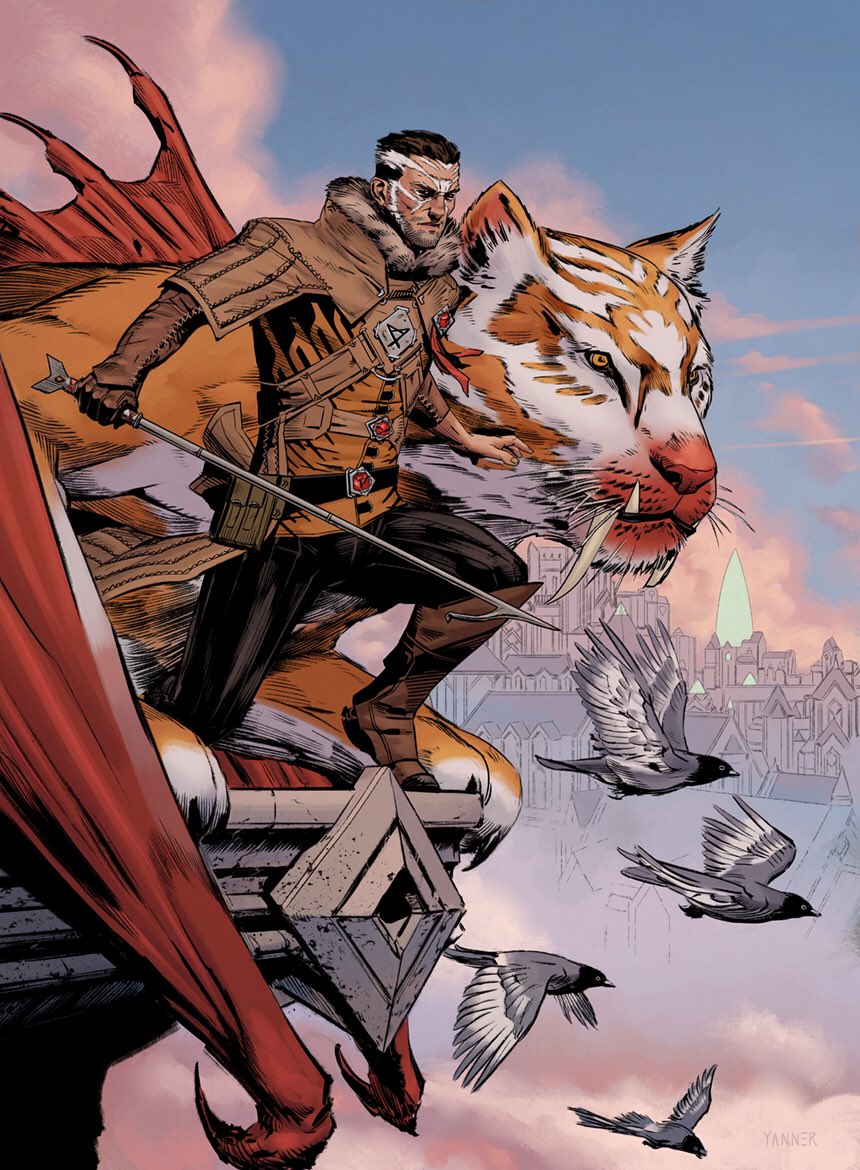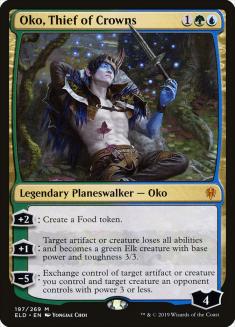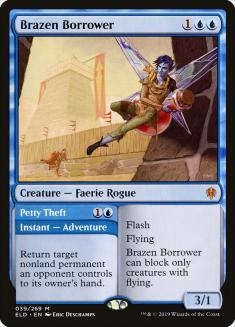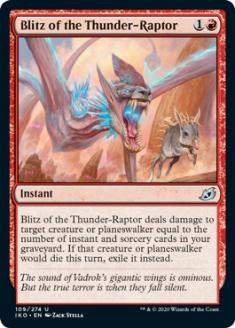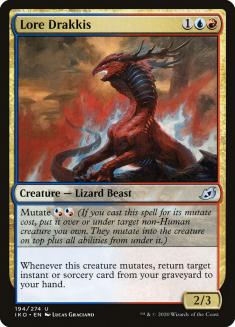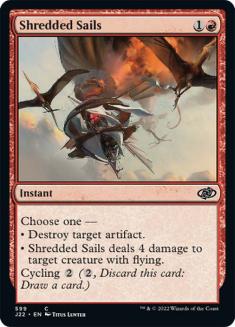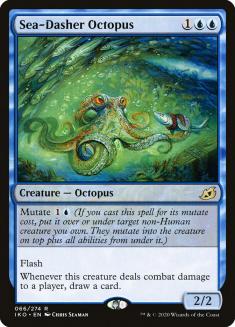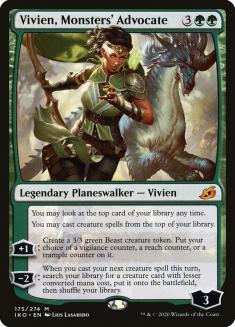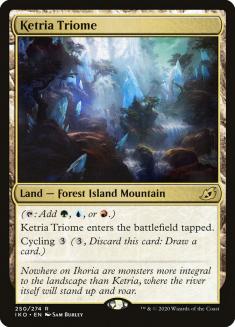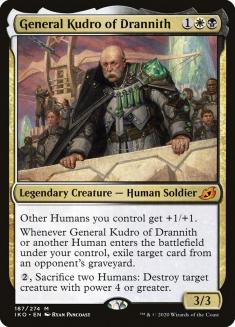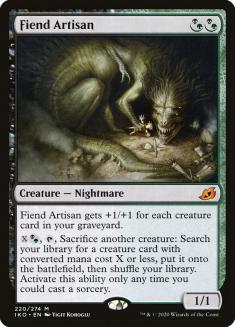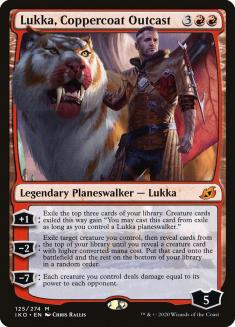For a while, I felt like I discovered the secret sauce for assessing the impact of new cards on the Modern format. While the masses focused on efficient threats and answers, I focused on only the most proactive and broken pieces of uninteractive cardboard that each set brought to the table. Modern was not the home of traditional Magic. The games were about ignoring your opponent and winning as quickly as possible.
In the last year, this all went out the window. Rapidly increasing card quality has blurred the line between reactive and proactive cards. Is Oko, Thief of Crowns a threat or an answer? How about Brazen Borrower? Is Uro, Titan of Nature’s Wrath an engine or a finisher? How do we classify Mystic Sanctuary and its effect on the Modern format?
The reintroduction of fair options to Modern has honestly felt like a bright spot in an otherwise tough period for Magic. While the play patterns around cards like Uro, Oko, and Arcum’s Astrolabe are far from my favorite, these cards dramatically altered the balance of power in the format without just adding or aiding linear combo — a rare feat in Modern’s history.
This development has forced me to completely revamp my heuristics for evaluating new Modern cards. In general, I’m far more open to a reactive cards than I would have been in the past, and I’m paying particularly close attention to cards that blur the lines of offense, defense, and utility. Ikoria: Liar of Behemoths doesn’t seem to have any immediate standouts along the lines of Uro, Oko, or Once Upon a Time (thankfully), but there is still a deep roster of playables that will make an impact. On to our list.
Honorable Mentions
Blitz of the Thunder Raptor is doing two things that have become vitally important in Modern: answering planeswalkers and exiling creatures. In old Izzet Phoenix setups, this card would have been a slam-dunk inclusion. As it stands now, it’s possible that decks like Grixis Death’s Shadow turn to this card as a potential late-game answer to Uro. The fail state of this card against something like Leyline of the Void keeps it from being higher on my list, but I do expect several existing decks to pick this up in small numbers.
I wrote about Lore Drakkis last week and while I was incredibly high on the card going as far back as Legacy, I’m less sure of its role in Modern. Lore Drakkis benefits from either the longer games of Standard or Legacy’s free spells like Force of Will and Daze. Modern mostly lacks both features. I’m not convinced that picking up a Force of Negation can have the same impact on controlling the early-game and buying back an Opt doesn’t hit the same when my opponents are just killing me on Turn 2. Perhaps Dimir and its Thoughtseizes benefit enough from a Lore Drakkis / Sea-Dasher Octopus team-up, but I am skeptical.
Big bodies for Living End don’t solve the deck’s fundamental problems in the format. Every form of disruption printed in the last decade has been great against Living End. I don’t think this deck is coming back.
Perhaps even more versatile than Abrade, Shredded Sails is just waiting for a metagame where midsized flying creatures exist. Burning this to kill an Ice-Fang Coatl doesn’t feel great, and there are few other meaningful flying creatures around. Given how broad the Modern format tends to be, answers this versatile are usually sideboarding godsends. This just isn’t Shredded Sails’s moment, though. It will get its chance.
10. Sprite Dragon
Sprite Dragon is the latest shot at enabling an archetype that has had a difficult time finding its footing in Modern. While Izzet Delver decks have had years of storied success in Legacy, the absence of free spells has left Modern versions trailing behind.
In a format light on Lightning Bolts, there’s no question that Sprite Dragon blows its predecessor, Stormchaser Mage, out of the water. The problem lies in the fact that these decks are still searching for meaningful interaction against a very linear Modern. Putting Sprite Dragon in your deck means you’re consenting to playing somewhat longer and more interactive games. If you weren’t, you’d turn towards something like Kiln Fiend or Runaway Steam-Kin instead.
The only way this approach makes sense to me is if you become highly incentivized to play blue interaction like Spell Pierce or Force of Negation. In the present format, I don’t feel like that’s the case. The best threats are creatures again (Uro, Urza, and Primeval Titan) and Path to Exile and Icefang Coatl are both present in large numbers, ready to invalidate your size advantage. There’s no question that Sprite Dragon has potential on rate. It just needs its targets to shift a bit.
9. Sea-Dasher Octopus
Speaking of cards that can benefit from the rise of blue interaction, here’s Sea-Dasher Octopus. The flexibility of this card is its biggest selling point. Having disruption options as early as Turn 2 is critical in Modern, and the flash of Sea-Dasher Octopus helps make Mana Leak a real card again. While Sprite Dragon asks you to cobble together just enough blue disruption to make its attacks lethal, Sea-Dasher Octopus can provide enough disruption for a blue deck to stand toe-to-toe with some of Modern’s more powerful foes. Here’s a first draft.
Creatures (13)
Lands (22)
Spells (25)

8. Vivien, Monsters’ Advocate
Vivien feels like the perfect sideboard shift for every green-based creature combo deck that exists in Modern. Elves, Devoted Druid, Mono-Green Devotion, Golgari Yawgmoth, and several others benefit from its simultaneous provision of card advantage and selection.
The real question is whether maindeck Viviens sufficiently power up archetypes that have been relegated to Tier 2 status. I think the answer is yes. The efficiency with which you find combo pieces goes through the roof with a Vivien on the battlefield. More importantly, every one of these decks previously felt utterly hopeless when they got the pairing against the rare removal-heavy deck like Burn or Death’s Shadow. Now creature combo has a one-card way to win any attrition war, derived from a permanent type that has been historically difficult to interact with in Modern.
7. Yorion, Sky Nomad
It seems obvious that blue-based control decks will make the transition to 80 cards with little trouble. Increased numbers of fetchlands for more virtual copies of Mystic Sanctuary is the type of upside that had more daring pilots already experimenting with larger deck sizes. Similarly, Scapeshift decks have previously pushed the 60-card limit in order to include the appropriate amounts of Mountains. While the “play 60” mindset does exist for a real and concrete reason, there’s no question that every maxim in Magic has moments it should be broken.
The real question is whether these reasons for deck expansion will overlap with permanents worth blinking. Bant Control already happily uses Arcum’s Astrolabe and Ice-Fang Coatl, and therefore seems like a fine starting point. Five-Color Niv-Mizzet decks have Arcum’s Astrolabe and a high-value target worth blinking in Niv-Mizzet Reborn. Increased deck size allows for more bullets to find with Bring to Light. Scapeshift may have to be rebuilt from the ground up to really leverage Yorion’s blink ability, but I think the potential payoff is there.
One deck with no lack of targets for Yorion is Bant Soulherder. While the deck was well outside the top tier during its last run, you can be sure it deserves a rebuild with Yorion in the mix. Perhaps there is even a version that can squeeze the Scapeshift combo alongside the typical Soulherder nonsense.
A companion’s worth is always going to be heavily influenced by the opportunity cost in playing the card. If deckbuilders find ways to make Yorion’s restrictions a boon, this card has some of the highest potential in the entire set.
6. Heartless Act
There isn’t much the say about Heartless Act that doesn’t amount to a restatement of its card text. As far as two-mana black removal goes, this probably kills a larger range of creatures than any of the other options. While Ultimate Price and Go for the Throat are fringe players at this stage of Modern’s lifespan, it is possible that the upgrade to Heartless Act gives existing black midrange decks that little push over the hump. Jund and Grixis Death’s Shadow should both be interested in small numbers of this card.
5. Ketria Triome
While Ketria Triome is legitimately the best of the bunch, all the Triomes will make their presence felt in Modern. Basic land types obviously mean far more in a format based on fetchlands. A single Triome should probably be part of every three-color Modern deck that has eyes on playing more than the bare minimum number of turns. Filling any mana inefficiency with superb fixing would mean a lot on its own, but the fact that you may even get to reclaim a draw step in the late-game by cycling just puts me over the moon on Triomes. Of course, entering the battlefield tapped is a real downside that could potentially rear its head. For this reason, I wouldn’t advocate Triomes in two-color decks or in the decks that don’t perfectly match Ikoria’s wedges.
My brain again drifts towards Valakut, the Molten Pinnacle and how much its off-kilter versions benefit from the addition of some new Mountains to the fold. This printing makes non-Primeval Titan Valakut decks look like real possibilities again, and diverse Mountains to go alongside Field of the Dead are always welcome as well.
4. General Kudro of Drannith
It’s weird to have such a narrow card this high on the list, but Humans is one of the few archetypes that has been through it all in Modern. Hogaak, Simic Urza, Izzet Phoenix… the Humans fought valiantly against all these foes. And while it has been a while since they’ve ruled the roost, it has always felt like they were right on the cusp of greatness yet again. I think General Kudro of Drannith is the push the archetype needed.
Uro is currently Public Enemy No. 1 in Modern, and General Kudro somehow deals with an Uro on the battlefield and in the graveyard. It’s also picking off key dredgers, Snapcaster Mage targets, and so many other focal points of present Modern. General Kudro can stop Primeval Titan from ending the game in a single turn. Even absurd things like Emrakul, the Aeons Torn fear this brilliant strategist. General Kudro is the perfect package of unassuming abilities that has its sights laser-focused on what matters in Modern.
3. Fiend Artisan
I previously discussed just how many creature combos exist in Modern now. Every single one benefits from the addition of Fiend Artisan to the format. Given that this card has been compared to Birthing Pod, it should surprise no one that I want to take another look at shenanigans involving persist creatures. This go-around, the undying creatures should also get a chance to shine alongside Yawgmoth, Thran Physician.
These are the obvious uses for Fiend Artisan, but it wouldn’t surprise me to find the card capable of so much more. Fiend Artisan sacrificing a Stitcher’s Supplier to go get another Stitcher’s Supplier and your graveyard is instantly juiced for a very affordable cost of just two mana. On top of that, your Fiend Artisan is now huge and capable of carrying the game on its own. How about playing fair with Bitterblossom, Fiend Artisan, and Death’s Shadow all working in concert with one another?
Creatures (19)
Lands (24)
Spells (17)

Of course, you could abandon the interactive plans and look towards unfair Vengevine and Creeping Chill starts. Fiend Artisan’s potential runs deep, across many archetypes. I’m looking forward to working on this one.
2. Lukka, Coppercoat Outcast
Say hello to the best Polymorph we’ve ever seen. It seems trivial to build your deck in such a way that Lukka’s -2 ability gets you whatever creature you want. The most obvious home for Lukka is in Gruul Midrange, where decks are currently playing Modern all-stars like *checks notes* Glorybringer in the five-mana slot. I would retool the creature curve to jump from one to three, to whatever curve-topper belongs at the top. Emrakul, the Aeons Torn is the obvious answer, but you can probably look at Sundering Titan, Progenitus, or a host of other finishers depending on the matchup.
There are plenty of other ways to maximize Lukka. Maybe it’s as simple as a bunch of one-mana Elves and Craterhoof Behemoths. The card asks so little of its caster and rewards you with potentially broken returns.
1. Lurrus of the Dream-Den
So much of this article can be distilled to opportunity costs. There are hundreds of superb Magic cards in Modern. The problem is that every inclusion costs you space for something else. Except Lurrus of the Dream-Den, which is just going to get to hop into a whole bunch of sideboards at very little cost and return a bunch of incredible permanents to its controllers’ battlefields. Let’s look at a deck that just won a PTQ this past weekend.
Creatures (12)
Lands (20)
Spells (28)
- 4 Lightning Bolt
- 4 Lava Spike
- 2 Lightning Helix
- 4 Rift Bolt
- 4 Searing Blaze
- 2 Skullcrack
- 4 Boros Charm
- 4 Skewer the Critics
Sideboard

Sweet, free Lurrus. Without changing anything about the deck besides a single sideboard slot, the deck picks up an eighth card in hand, a source of lifegain, and recursive access to some of its best threats. Small creature decks will be able to get up to similar tricks and this doesn’t even contemplate specifically building around Lurrus.
You saw my efforts above with Fiend Artisan. What if we returned Kroxa to the battlefield every single turn? How many ways can you rebuild Death’s Shadow? Can blue control dispense with its planeswalkers to rebuy Mishra’s Baubles and Snapcaster Mages? There are a bunch of unanswered questions around maximizing companion, but Lurrus eliminates half the puzzle by naturally slotting in a bunch of homes without any real deckbuilding restrictions.
It may not be the card that completely changes the face of Modern, but we are unquestionably going to see a lot of Lurrus over the coming months.

